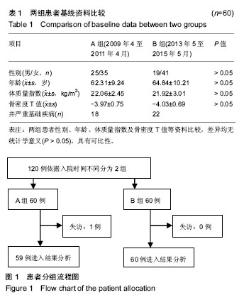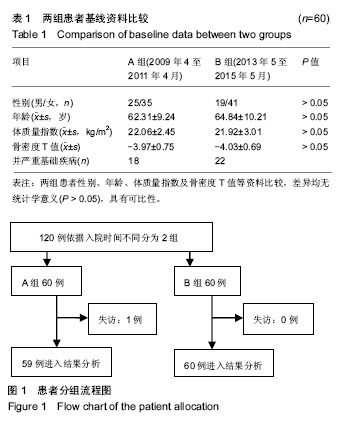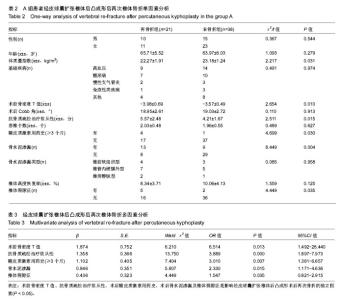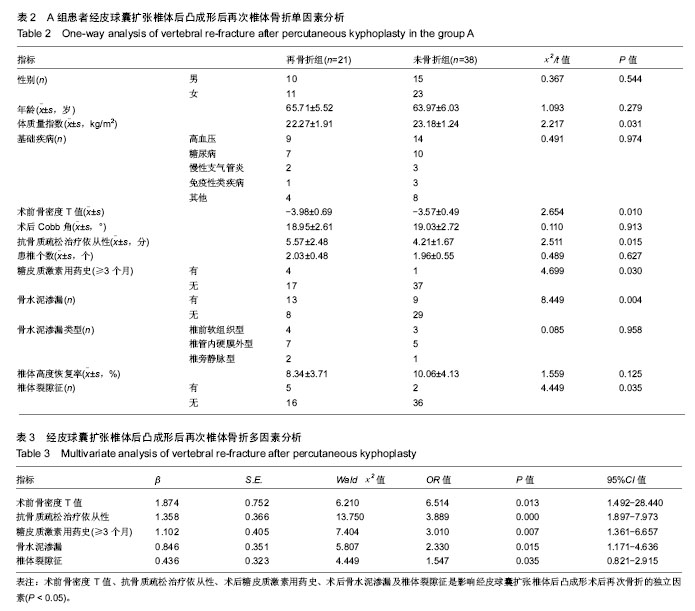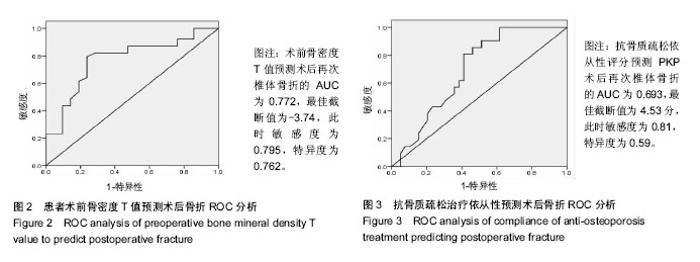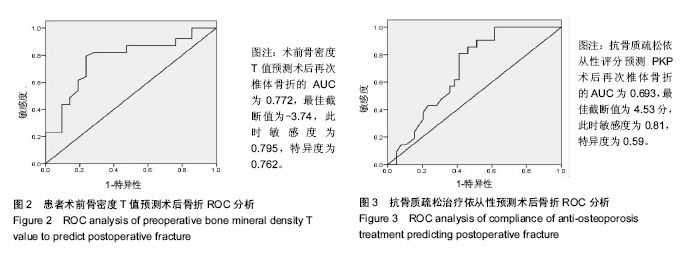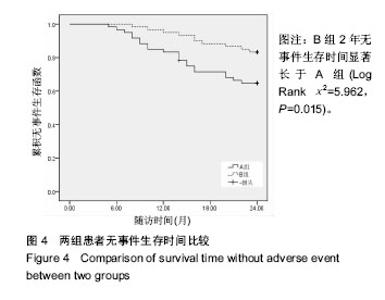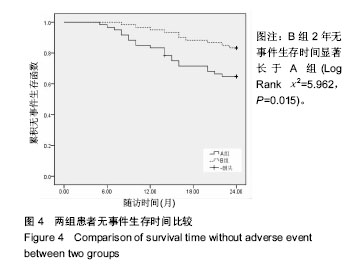| [1] Lin X,Xiong D,Peng YQ,et al.Epidemiology and management of osteoporosis in the People's Republic of China: current perspectives.Clin Interv Aging.2015;10(1):1017-1033.[2] 唐汉武,林一峰,孙丽,等.骨质疏松性椎体压缩性骨折的临床特点分析[J].广州中医药大学学报,2014,31(1):7-10.[3] Wang S,Wang Q,Kang J,et al.An imaging anatomical study on percutaneous kyphoplasty for lumbar via a unilateral transverse process-pedicle approach.Spine. 2014;39(9):701-706.[4] Gan M,Zou J,Song D,et al.Is balloon kyphoplasty better than percutaneous vertebroplasty for osteoporotic vertebral biconcave-shaped fractures.Acta Radiologica. 2014;55(8): 985-991.[5] 叶向阳,汤立新,程省,等.骨密度对骨质疏松性椎体压缩性骨折PKP术后骨折再发风险的评估价值[J].中国骨质疏松杂志, 2017, 23(2):154-158.[6] 胡乐,王永祥.PVP/PKP术后继发邻近椎体骨折危险因素的研究进展[J].中国脊柱脊髓杂志,2017,27(4):377-380.[7] 印平,马远征,马迅,等.骨质疏松性椎体压缩性骨折的治疗指南[J].中国骨质疏松杂志,2015,21(6):643-648.[8] Alsous M, Alhalaiqa F, Abu F R, et al. Reliability and validity of Arabic translation of Medication Adherence Report Scale (MARS) and Beliefs about Medication Questionnaire (BMQ)-specific for use in children and their parents. Plos One.2017;12(2):1-14.[9] 杨朝林,刘日新,袁国奇,等.骨质疏松压缩骨折经皮椎体成形术伤椎高度变化的MSCT与临床疗效的评价[J].中国CT和MRI杂志, 2015,13(4):107-110.[10] 刘军,邢更彦.骨质疏松与骨关节炎的相关性研究进展[J].中国矫形外科杂志,2014, 22(15):1389-1392.[11] 赵毅,柳根哲,彭亚,等.单纯PKP与PKP结合过伸复位法治疗新鲜骨质疏松椎体压缩性骨折的对比研究[J].世界中西医结合杂志, 2016,11(8):1156-1158.[12] 曹勇,蒋栋,洪晔,等.经皮球囊扩张椎体后凸成形术治疗骨质疏松性椎体压缩性骨折68例分析[J].江苏医药, 2016,42(21): 2398-2400.[13] 李铠湘,李文锐.骨质疏松性椎体骨折PVP/PKP术后新发骨折的相关因素[J].中国矫形外科杂志,2017,25(10):907-911.[14] 郭刚,赵海燕.青春后期女性骨密度及血清钙离子和甲状旁腺激素水平[J].中国学校卫生,2013,34(8):1000-1003.[15] 吴骞,陈建庭,钟招明,等.中老年人正位腰椎及髋部骨密度扫描对骨质疏松诊断敏感性的比较[J].中国骨质疏松杂志,2010,16(12): 940-941.[16] 解凡,张云.绝经期后女性双髋部和腰椎部骨密度值在骨质疏松诊断中敏感性的比较[J].辽宁医学杂志,2013,27(5).220-222.[17] Zhang C,Zhu K,Zhou J,et al.Influence on adjacent lumbar bone density after strengthening of T12, L1 segment vertebral osteoporotic compression fracture by percutaneous vertebroplasty and percutaneous kyphoplasty. Zhongguo Xiu Fu Chong Jian Wai Ke Za Zhi. 2013;27(7):819-823.[18] 彭冉东,邓强,李中锋,等.骨质疏松性椎体压缩骨折PKP术后近期手术椎体再骨折原因探讨[J].实用骨科杂志, 2017,23(9): 781-785.[19] 王涛,范恒俊,张福利,等.PKP后骨折椎体及邻近椎体应力变化有限元分析[J].山东医药,2014,54(22):8-10.[20] Katzman WB,Vittinghoff E,Kado DM, et al.Thoracic kyphosis and rate of incident vertebral fractures: the Fracture Intervention Trial. Osteoporos Int. 2016;27(3):899-903. [21] 郑勇,王剑,刘先齐,等.骨密度与经皮椎体后凸成形术疗效的相关性研究[J].检验医学与临床, 2017, 14(14):2094-2096.[22] Liu T,Zhe L,Su Q,et al.Cement leakage in osteoporotic vertebral compression fractures with cortical defect using high-viscosity bone cement during unilateral percutaneous kyphoplasty surgery. Medicine.2017;96(25):1-5.[23] 易志坚,曹家树,王茂林,等.经皮椎体成形术后椎体再发骨折的危险因素分析[J].颈腰痛杂志,2013,34(6):474-476.[24] 吴爱悯,倪文飞,池永龙.椎体内裂隙征的形成机理、影像学特征及手术治疗[J].脊柱外科杂志,2012,10(1):56-59.[25] 王庆武,强晓军,王振江.预防性注入骨水泥防止骨质疏松继发性脊椎骨折疗效分析[J].中国医学创新,2011,8(13):129-130.[26] Yao W,Dai W,Jiang L,et al.Sclerostin-antibody treatment of glucocorticoid-induced osteoporosis maintained bone mass and strength.Osteoporosis Int.2016;27(1):283-294.[27] 张学武,姚海红,梅轶芳,等. 全国多中心使用糖皮质激素风湿病患者骨质疏松调查[J].中华临床免疫和变态反应杂志, 2017, 11(3):277-284.[28] 赵志刚,勘武生,李鹏,等.经皮椎体成形术治疗新鲜骨质疏松性椎体压缩性骨折[J].中华创伤骨科杂志,2014,16(3):218-221.[29] 张义龙,任磊,孙志杰,等.椎体成形术后新发椎体骨折与脊柱矢状位参数的相关性分析[J].重庆医学,2017,46(4):483-485.[30] 张义龙,任磊,孙志杰,等.椎体成形后新发椎体压缩骨折:与骨质疏松及脊柱矢状位序列失衡有关[J].中国组织工程研究, 2016, 20(35):5263-5269.[31] Zhao G,Liu X,Li F.Balloon kyphoplasty versus percutaneous vertebroplasty for treatment of osteoporotic vertebral compression fractures (OVCFs).Osteoporosis Int. 2016;27(9): 1-12.[32] 葛云林,陶利江,卢一生.经皮球囊扩张椎体后凸成形术术后再发椎体骨折的危险因素和防治策略[J].颈腰痛杂志, 2016,37(5): 404-407. |
